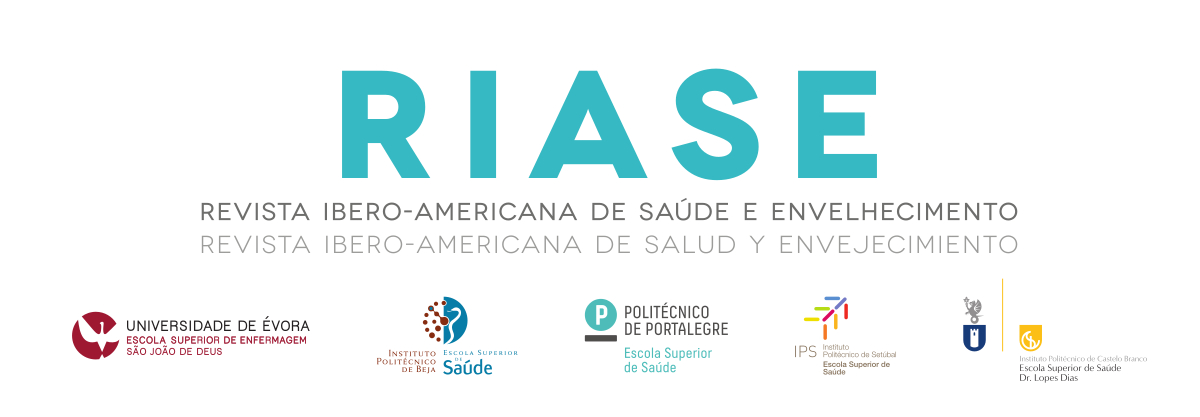INFLUÊNCIAS NA NOTIFICAÇÃO DE INCIDENTES EM AMBIENTE HOSPITALAR: UMA ANÁLISE DOS PRINCIPAIS FATORES
Resumo
Introdução: A gestão do risco constitui um instrumento fundamental para garantir a segurança do doente e um dos seus principais pilares são os sistemas de notificação de incidentes. Porém a subnotificação ameaça a utilidade destes sistemas. Objetivo: Identificar os fatores que influenciam o processo da notificação de incidentes de segurança do doente em contexto hospitalar. Métodos: A pesquisa foi efetuada por dois revisores separadamente e dividiu-se em três momentos distintos. Com recurso à base de dados científica da Medline (PubMed), foram considerados os artigos cujo título e resumo fossem mais relevantes para o objetivo em estudo. De seguida, foram considerados os artigos que respeitassem os seguintes critérios de inclusão: estudos escritos em língua portuguesa ou inglesa, com dados sobre população adulta em âmbito hospitalar, cujos resumos continham os descritores previamente definidos ou termos com significados equivalentes e publicados após o relatório To Er ris Human (2000), sendo este um marco mundial da segurança do doente e a partir do qual se implementou globalmente os sistemas de notificação. Por fim, os revisores analisaram integralmente os artigos, sendo considerados apenas os que se encontravam em concordância pelos dois. Resultados: O feedback após a notificação (38,46%), uma cultura não-punitiva (38,46%), a liderança (30,77%), fatores organizacionais (30,77%), simplicidade do processo de notificação (69,23%), conhecimento/competências (58,85%) e um ambiente laboral adequado (30,77%), foram os 7 principais fatores identificados. Conclusão: Ao identificarmos os principais aspetos que melhoram a taxa de notificação de incidentes nos hospitais (em quantidade e qualidade), reforçamos as características de um bom sistema de notificação de incidentes (confidencial, não-punitivo, independente, com dados e análises de peritos da área disponíveis em tempo útil e orientado para mudanças nos sistemas e nos processos), como forma de alcançar o seu potencial na segurança do doente. Palavras-chave: Notificação de incidentes Hospitalares; Notificação voluntária de incidentes de segurança; Notificação de incidentes de segurança do doente; Gestão de risco de saúde.
Referências
Referências bibliográficas
Kudzma EC. Florence Nightingale and healthcare reform. Nurs Sci Q. 2006;19(1):61-64. doi:10.1177/0894318405283556.
Dervishaj O, Wright KE, Saber AA, Pappas PJ. Ernest Amory Codman and the End-result System. Am Surg. 2015;81(1):12-15. doi:10.1177/000313481508100109.
World Health Organization. Global Patient Safety Action Plan 2021–2030: towards eliminating avoidable harm in health care. Geneva: World Health Organization; 2021. https://www.who.int/publications/i/item/9789240032705. Consultado em 10 fevereiro 2023.
National Patient Safety Agency. Healthcare Risk Assessment Made Easy. London: National Health Service; 2007. http://www.mtpinnacle.com/pdfs/Healthcare_Risk_Assess.pdf. Consultado em 10 fevereiro 2023.
Scrivens E. Quality Risk and Control in Health Care. Maidenhead: Open University Press; 2005.
Direção Geral da Saúde. Plano Nacional de Saúde 2012-2016. https://pns.dgs.pt/files/2013/05/PNS2012_2016_versaoresumo_maio20133.pdf. Consultado em 10 fevereiro 2023.
Direção Geral da Saúde. Plano Nacional para a Segurança dos Doentes 2021-2026. https://www.dgs.pt/qualidade-e-seguranca/seguranca-dos-doentes/plano-nacional-para-a-seguranca-dos-doentes-2021-2026.aspx. Consultado em 20 fevereiro 2023.
Direção Geral da Saúde. Norma 017/2022 de 19/12/2022 – Notificação e Gestão de Incidentes de Segurança do Doente – Otimização do processo de notificação e gestão de incidentes de segurança do doente. https://www.dgs.pt/normas-orientacoes-e-informacoes/normas-e-circulares-normativas/norma_017_2022-de-19_12_2022-pdf.aspx. Consultado em 20 fevereiro 2023.
Sari AB, Sheldon TA, Cracknell A, Turnbull A. Sensitivity of routine system for reporting patient safety incidents in an NHS hospital: retrospective patient case note review. BMJ. 2007;334(7584):79. doi:10.1136/bmj.39031.507153.AE.
Aaronson EL, Brown D, Benzer T, Natsui S, Mort E. Incident Reporting in Emergency Medicine: A Thematic Analysis of Events. J Patient Saf. 2019;15(4):e60-e63. doi:10.1097/PTS.0000000000000399.
Lee WH, Zhang E, Chiang CY, et al. Comparing the Outcomes of Reporting and Trigger Tool Methods to Capture Adverse Events in the Emergency Department. J Patient Saf. 2019;15(1):61-68. doi:10.1097/PTS.0000000000000341.
Naessens JM, Campbell CR, Huddleston JM, et al. A comparison of hospital adverse events identified by three widely used detection methods. Int J Qual Health Care. 2009;21(4):301-307. doi:10.1093/intqhc/mzp027.
World Health Organization. Patient safety incident reporting and learning systems: technical report and guidance. Geneva: World Health Organization; 2020. https://www.who.int/publications/i/item/9789240010338. Consultado em 10 fevereiro 2023.
Joanna Briggs Institute. Developed by the Joanna Briggs Institute Levels of Evidence and Grades of Recommendation Working Party October 2013. Adelaide: Joanna Briggs Institute; 2013. [acedida 10 de Fevereiro 2023]. Disponível em: https://jbi.global/sites/default/files/2019-05/JBI-Levels-of-evidence_2014_0.pdf.
Joanna Briggs Institute. Developed by the Joanna Briggs Institute Levels of Evidence and Grades of Recommendation Working Party October 2013. Adelaide: Joanna Briggs Institute; 2013. [acedida 10 de Fevereiro 2023]. Disponível em: https://jbi.global/sites/default/files/2019-05/JBI-grades-of-recommendation_2014.pdf.
Alves MFT, Carvalho DS, Albuquerque GSC. Barriers to patient safety incident reporting by Brazilian health professionals: an integrative review. Motivos para a não notificação de incidentes de segurança do paciente por profissionais de saúde: revisão integrativa. Cien Saude Colet. 2019;24(8):2895-2908. Published 2019 Aug 5. doi:10.1590/1413-81232018248.23912017.
Yalew ZM, Yitayew YA. Clinical incident reporting behaviors and associated factors among health professionals in Dessie comprehensive specialized hospital, Amhara Region, Ethiopia: a mixed method study. BMC Health Serv Res. 2021;21(1):1331. Published 2021 Dec 11. doi:10.1186/s12913-021-07350-y.
Ngo J, Lau D, Ploquin J, Receveur T, Stassen K, Del Castilho C. Improving incident reporting among physicians at south health campus hospital. BMJ Open Qual. 2022;11(4): e001945. doi:10.1136/bmjoq-2022-001945.
Burlison JD, Quillivan RR, Kath LM, et al. A Multilevel Analysis of U.S. Hospital Patient Safety Culture Relationships With Perceptions of Voluntary Event Reporting. J Patient Saf. 2020;16(3):187-193. doi:10.1097/PTS.0000000000000336.
Archer S, Hull L, Soukup T, et al. Development of a theoretical framework of factors affecting patient safety incident reporting: a theoretical review of the literature. BMJ Open. 2017;7(12): e017155. Published 2017 Dec 27. doi:10.1136/bmjopen-2017-017155.
Alzahrani N, Jones R, Abdel-Latif ME. Attitudes of doctors and nurses toward patient safety within emergency departments of two Saudi Arabian hospitals. BMC Health Serv Res. 2018;18(1):736. Published 2018 Sep 25. doi:10.1186/s12913-018-3542-7.
Evans SM, Berry JG, Smith BJ, et al. Attitudes and barriers to incident reporting: a collaborative hospital study. Qual Saf Health Care. 2006;15(1):39-43. doi:10.1136/qshc.2004.012559.
Waring JJ. A qualitative study of the intra-hospital variations in incident reporting. Int J Qual Health Care. 2004;16(5):347-352. doi:10.1093/intqhc/mzh068.
Dhamanti I, Leggat S, Barraclough S, Rachman T. Factors contributing to under-reporting of patient safety incidents in Indonesia: leaders' perspectives. F1000Res. 2021; 10:367. Published 2021 May 10. doi:10.12688/f1000research.51912.2.
Chiang HY, Lee HF, Lin SY, Ma SC. Factors contributing to voluntariness of incident reporting among hospital nurses. J Nurs Manag. 2019;27(4):806-814. doi:10.1111/jonm.12744.
Mitchell I, Schuster A, Smith K, Pronovost P, Wu A. Patient safety incident reporting: a qualitative study of thoughts and perceptions of experts 15 years after 'To Err is Human'. BMJ Qual Saf. 2016;25(2):92-99. doi:10.1136/bmjqs-2015-004405.
Reznek MA, Barton BA. Improved incident reporting following the implementation of a standardized emergency department peer review process. Int J Qual Health Care. 2014;26(3):278-286. doi:10.1093/intqhc/mzu045.
Woo MWJ, Avery MJ. Nurses' experiences in voluntary error reporting: An integrative literature review. Int J Nurs Sci. 2021;8(4):453-469. Published 2021 Aug 2. doi: 10.1016/j.ijnss.2021.07.004.
Stemn E, Bofinger C, Cliff D, Hassall ME. Failure to learn from safety incidents: Status, challenges and opportunities. Safety science. 2018 Jan 1; 101:313-25.
DOI: http://dx.doi.org/10.60468/r.riase.2023.9(4).615.24-47
Apontamentos
- Não há apontamentos.


